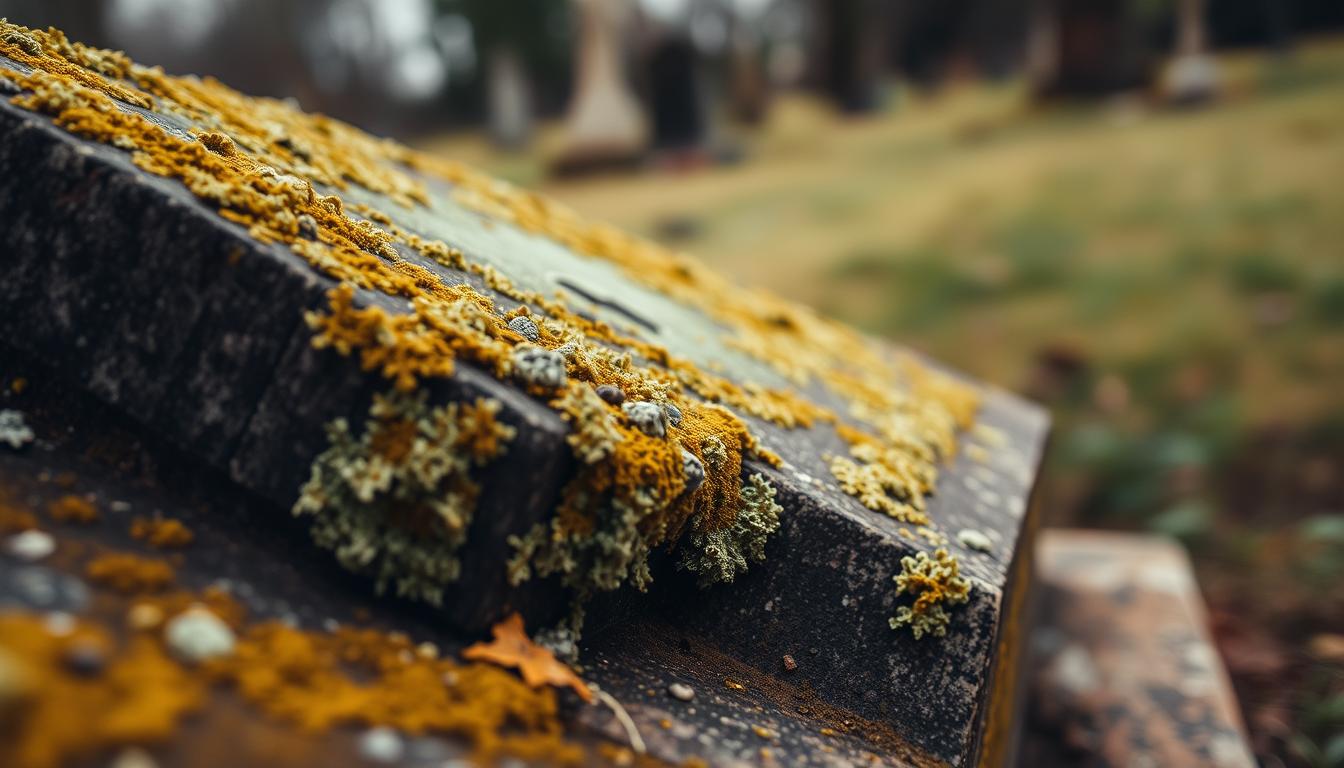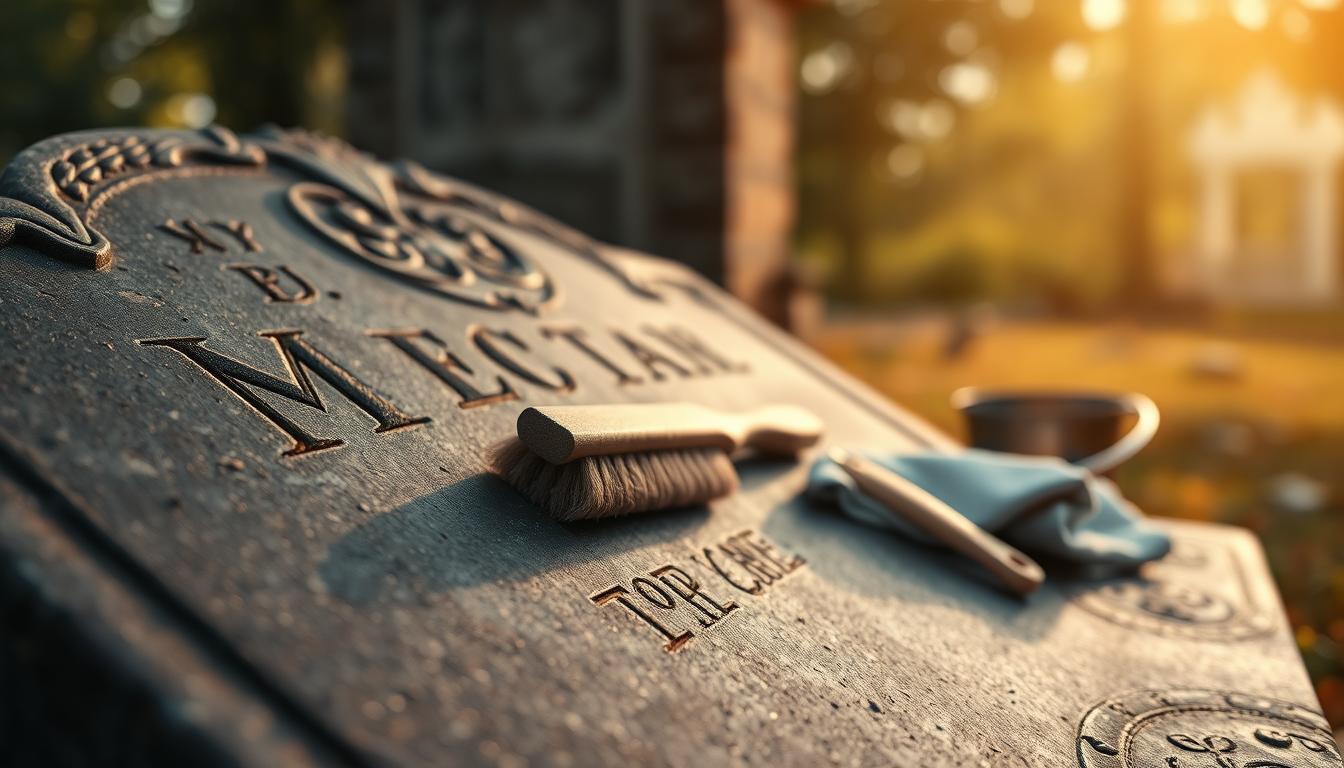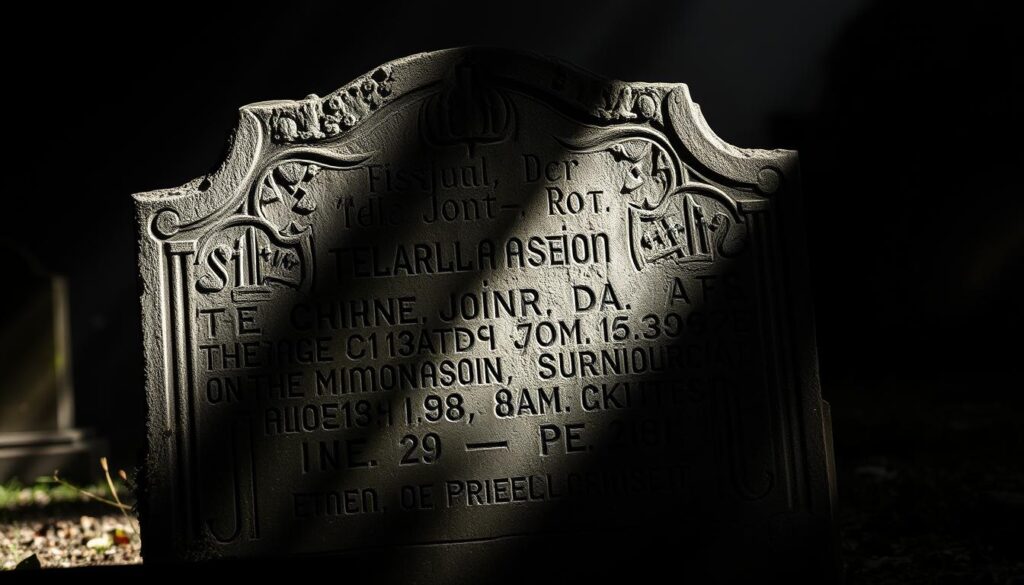Over time, gravestones can develop unsightly biological growth, including lichen, moss, algae, and fungi. These growths can cause significant damage to the stone surface if left untreated. They trap moisture and secrete acids that can dissolve materials like limestone, marble, and sandstone.
You may notice that your headstone has become discolored or stained due to the presence of these organisms. It’s essential to understand when and how to clean a stone to preserve its integrity and historical significance. Aggressive cleaning methods can cause irreparable harm, so it’s crucial to approach this task with care.
Key Takeaways
- Biological growth can severely damage gravestones if not addressed.
- Proper cleaning techniques are essential to preserve historical significance.
- Understanding when to clean and when to leave a stone untouched is crucial.
- The right tools and solutions can make a significant difference in gravestone maintenance.
- Preserving the surface of the stone is vital to maintaining its integrity.
Understanding Biological Growth on Gravestones
As you examine your gravestone, you may notice various forms of biological growth that can compromise its surface and structure. Biological growth on gravestones is a widespread issue that affects not only the appearance but also the longevity of the stone.
Types of Growth: Lichen, Moss, Algae, and Fungi
Biological growth on gravestones encompasses several distinct organisms, each with its unique characteristics and potential for damage. Lichen, for instance, appears as flat, crusty patches in various colors and forms a symbiotic relationship between fungi and algae. Moss, on the other hand, thrives in damp, shaded areas, forming soft, fuzzy green mats that retain moisture against the stone surface. Algae typically appears as green or black staining and secretes acids that can dissolve calcium carbonate in marble and limestone. Fungi can penetrate deeply into porous stone, causing significant internal damage.
| Type of Growth | Appearance | Damage Potential |
|---|---|---|
| Lichen | Flat, crusty patches | Penetrates stone pores, causes cracking |
| Moss | Soft, fuzzy green mats | Retains moisture, accelerates deterioration |
| Algae | Green or black staining | Secretes acids, dissolves stone minerals |
| Fungi | Black or brown spots | Penetrates deeply, causes internal damage |
How Biological Growth Damages Stone
These biological organisms damage stone through three primary mechanisms: trapping moisture against the surface, secreting acidic compounds that dissolve stone minerals, and physical penetration that widens existing cracks and creates new ones. The damage caused by biological growth can be particularly problematic for stones like marble and limestone, which are vulnerable due to their calcium carbonate composition.
Understanding the types of biological growth and their damage potential is crucial for maintaining the integrity of your gravestone. By recognizing the signs of biological growth, you can take appropriate measures to mitigate its effects and preserve the stone.
When to Clean vs. When to Leave Alone
Not every gravestone requires cleaning; sometimes, it’s better to leave it alone. The patina of age on a headstone is often mistaken for dirt that needs removal. However, aggressive cleaning can cause irreparable damage and destroy the stone’s historical significance.
Assessing the Need for Cleaning
To determine if a stone needs cleaning, inspect it carefully. Biological growth can be a sign of deterioration, but it can also be a natural part of the stone’s aging process. Consider the environment around the monuments in the cemetery. Dense foliage can create shade, promoting biological growth.
Evaluating Stone Condition and Stability
Before cleaning, evaluate the stone’s condition. Check for signs of instability such as cracks, flaking surfaces, or a gritty texture. The type of stone is also crucial; marble and limestone are more susceptible to damage than granite or slate. Consider the time of year and weather conditions to avoid causing additional stress to the stone.
| Stone Type | Cleaning Sensitivity | Recommended Care |
|---|---|---|
| Marble | High | Gentle cleaning, avoid harsh chemicals |
| Limestone | High | Gentle cleaning, avoid harsh chemicals |
| Granite | Low | Regular cleaning, gentle methods |
| Slate | Low | Regular cleaning, gentle methods |
By carefully assessing the need for cleaning and evaluating the stone’s condition, you can ensure that your headstone or grave marker receives the appropriate care. This thoughtful approach helps preserve the monuments in the cemetery for years to come.
Essential Tools for Safe Gravestone Lichen Removal
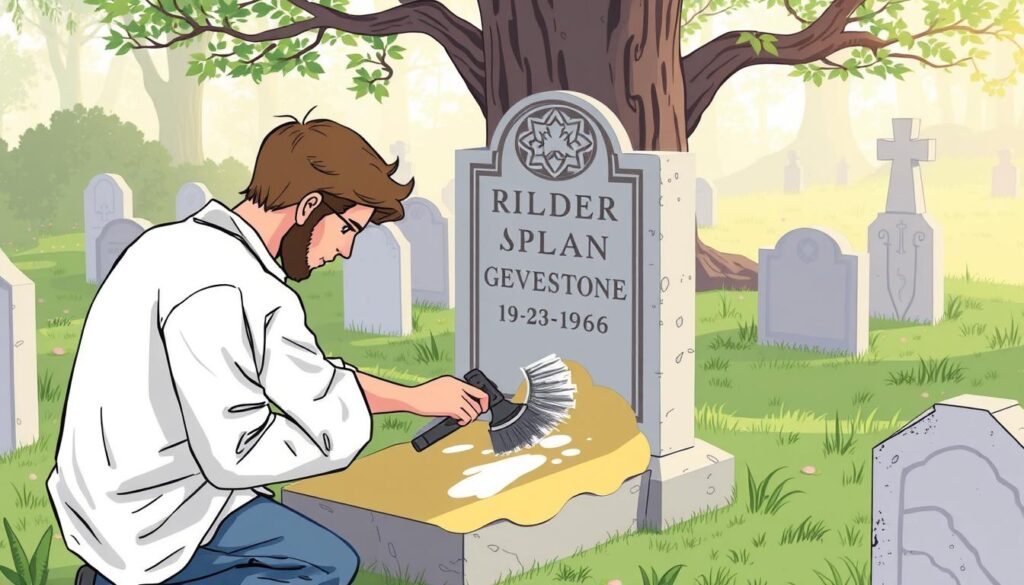
To safely remove lichen from a gravestone, you’ll need a specific set of tools. The right equipment ensures that the stone is cleaned effectively without causing damage. Selecting the proper tools is crucial for preserving the integrity of the headstone.
Recommended Brushes and Scrapers
For cleaning gravestones, soft-bristled brushes made of nylon or natural fibers are recommended. These brushes should have bristles that bend easily under light pressure to avoid scratching the stone surface. For stubborn lichen growths, use wooden tools like popsicle sticks or bamboo skewers, as they are softer than stone and won’t cause abrasion.
Water Sources and Sprayers
Water is your primary cleaning agent. Bring at least 5 gallons per gravestone in clean containers or use a low-pressure pump sprayer. Avoid high-pressure washers that exceed 90 psi, as they can damage the stone. For gentle application, especially on delicate stones like marble, use clean, absorbent cloths or natural sponges.
Safe Cleaning Solutions
For removing lichen and moss, consider using a headstone cleaner like D/2 Biological Solution. This product is non-ionic, biodegradable, and has been approved for use on national monuments. Avoid household cleaners, including dish soap, bleach, or vinegar, as they contain harmful chemicals that can damage the stone.
Step-by-Step Cleaning Process
Before you start cleaning your gravestone, it’s crucial to understand the steps involved in safely restoring its surface. Cleaning a headstone requires a gentle approach to remove biological growth without damaging the stone.
Preparation and Initial Assessment
Begin by thoroughly assessing the gravestone’s condition. Check for cracks, flaking, or instability that might make cleaning unsafe. It’s also a good idea to photograph the stone to document its pre-cleaning condition. Choose a mild day, between 50-80°F, for cleaning to avoid stressing the stone with extreme temperatures.
Basic Water Cleaning Method
For basic cleaning, start by thoroughly wetting the stone with running water from a hose. Then, use a soft-bristled brush to gently scrub the surface, working from the bottom of the stone upward in a circular motion. This method helps prevent streaking as clean water drains downward. For many gravestones, this simple method is sufficient to remove dirt and minor biological growth.

Using D/2 Biological Solution for Stubborn Growth
When dealing with stubborn lichen or biological growth, apply D/2 Biological Solution directly to the pre-wetted stone. Allow the solution to remain on the surface for 1-2 minutes, or up to 10 minutes for heavy growth. Use a soft-bristled brush to gently scrub the surface, maintaining a wet surface by applying additional D/2 as needed. Lightly mist with water and continue gentle scrubbing.
“The use of D/2 Biological Solution has revolutionized the cleaning of historical monuments and gravestones, offering a safe and effective method for removing biological growth.”
Proper Rinsing and Finishing Techniques
After cleaning, thoroughly rinse the stone with clean water for at least five minutes to remove all cleaning solution and loosened biological material. This step is crucial to prevent any residue from affecting the stone’s appearance or integrity over time. Ensure that the surface is clean and free of streaks.
By following these steps, you can safely clean your gravestone and restore its original appearance. Remember, if at any point during cleaning the stone shows signs of instability, stop immediately and consult a conservation professional.
What Never to Do When Cleaning Gravestones
To preserve the integrity of gravestones, certain cleaning approaches should be avoided at all costs. Cleaning headstones is a delicate task that requires careful consideration to prevent damage to the stone. Some methods, although seemingly effective, can cause irreversible harm to the monument and potentially accelerate its deterioration.
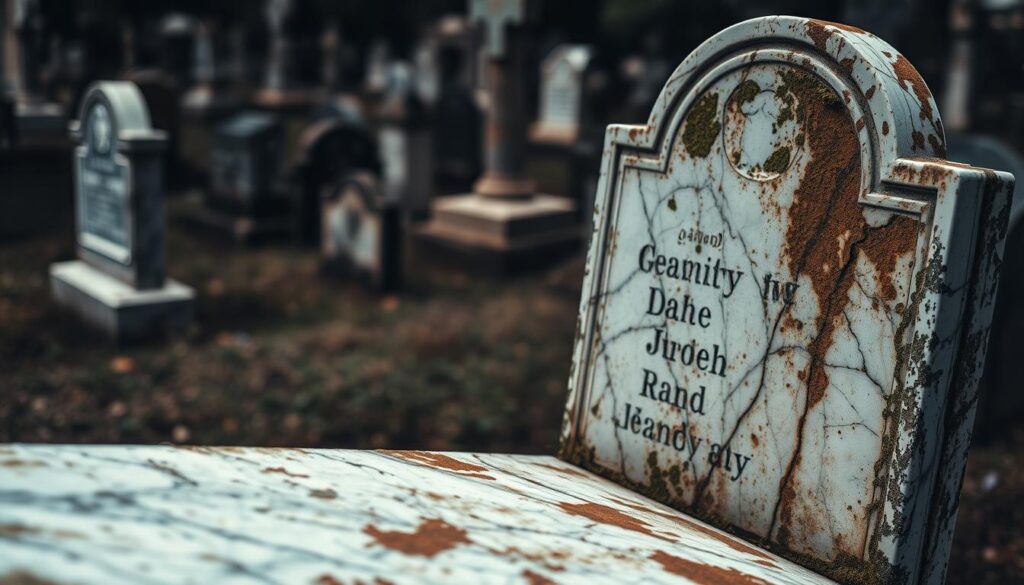
Harmful Chemicals to Avoid
When cleaning gravestones, it’s essential to avoid using harsh chemicals that can damage the stone. Bleach, for instance, contains salts that can penetrate the stone and cause erosion, yellowing, and long-term deterioration. Similarly, acidic cleaners, including vinegar and lemon juice, can dissolve marble and limestone, creating an inappropriate glossy surface and irreversible damage. You should also avoid using pool chlorine, as it can have identical detrimental effects.
- Never use bleach (sodium hypochlorite) or pool chlorine (calcium hypochlorite) on gravestones.
- Avoid all acidic cleaners, including vinegar, lemon juice, or commercial limestone cleaners.
Damaging Tools and Techniques
In addition to harmful chemicals, certain tools and techniques can also cause damage to gravestones. Avoid using metal tools, wire brushes, or abrasive pads that are harder than the stone itself, as these can scratch and permanently damage the surface. You should also refrain from using sandblasting or pressure washing, even with “soft” materials, as these methods can strip away the stone’s surface and accelerate deterioration.
Weather Considerations and Timing
The timing of your cleaning is also crucial. Avoid cleaning during freezing temperatures or when frost is expected within 24 hours, as water trapped in the stone can freeze and cause cracking. Similarly, avoid cleaning during extreme heat, as rapid drying can cause mineral deposits to form on the stone’s surface. It’s also important not to apply sealants, waxes, or consolidants unless you’re a trained conservator, as these products can trap moisture inside the stone and accelerate damage.
By being mindful of these potential pitfalls, you can ensure that your efforts to clean and maintain gravestones are effective and safe.
Maintaining Clean Gravestones for Years to Come
The key to preserving the integrity of a headstone lies in a well-planned maintenance schedule. To keep your loved one’s headstone in good condition, it’s essential to strike a balance between cleaning and preservation.
Cleaning a gravestone every 4 to 6 years is recommended to prevent excess wear. This timeframe allows you to remove biological growth or stains without causing unnecessary damage to the stone. It’s also crucial to document each cleaning with photographs and written records, noting the date, methods used, and any areas of concern for future reference.
To minimize the need for frequent cleaning, consider the overall condition of the cemetery site. Planting ground covers like buffalo grass around headstones can reduce the need for weed trimmers and herbicides that can damage stones. Trimming trees and shrubs near gravestones increases sunlight and airflow, naturally reducing the growth of moisture-loving organisms.
Regularly removing fallen leaves, branches, and debris from around the gravestone can also prevent moisture retention and organic acid damage. For family plots, consider organizing a rotation schedule among family members for regular site visits and minimal maintenance. By taking these steps, you can ensure that your loved one’s headstone remains a dignified and lasting tribute.
FAQ
What is the best way to clean a marble headstone?
To clean a marble headstone, you should use a soft-bristled brush and a mild soap solution. Avoid using harsh chemicals or abrasive materials that can damage the stone. For more stubborn growth, consider using a product like D/2 Biological Solution, which is specifically designed for cleaning stone surfaces.
How often should I clean my family’s gravestone?
The frequency of cleaning depends on the environment and the type of stone. As a general rule, you should inspect your family’s gravestone at least once a year and clean it as needed. If you live in an area with high levels of rainfall or near trees, you may need to clean the stone more frequently.
Can I use bleach to remove lichen from a gravestone?
No, you should avoid using bleach or other harsh chemicals to remove lichen from a gravestone. Bleach can damage the stone, cause discoloration, and harm the surrounding environment. Instead, opt for a gentle cleaning solution and a soft-bristled brush to safely remove lichen and other biological growth.
What are some common mistakes to avoid when cleaning a gravestone?
When cleaning a gravestone, avoid using wire brushes, harsh chemicals, or high-pressure washes, as these can damage the stone or cause erosion. Additionally, be mindful of the weather and avoid cleaning during extreme temperatures or when the stone is wet.
How can I prevent biological growth from returning to a cleaned gravestone?
To prevent biological growth from returning, ensure the stone is thoroughly rinsed and dried after cleaning. You can also consider applying a stone treatment or sealant to help protect the surface. Regular inspections and maintenance can also help prevent the return of lichen, moss, and other growth.
Are there any specific tools or equipment recommended for cleaning gravestones?
Yes, it’s recommended to use soft-bristled brushes, gentle cleaning solutions, and low-pressure sprayers to clean gravestones. Avoid using metal scrapers or wire brushes, as these can scratch or damage the stone. For more stubborn growth, consider using a product like D/2 Biological Solution and a soft-bristled brush.

